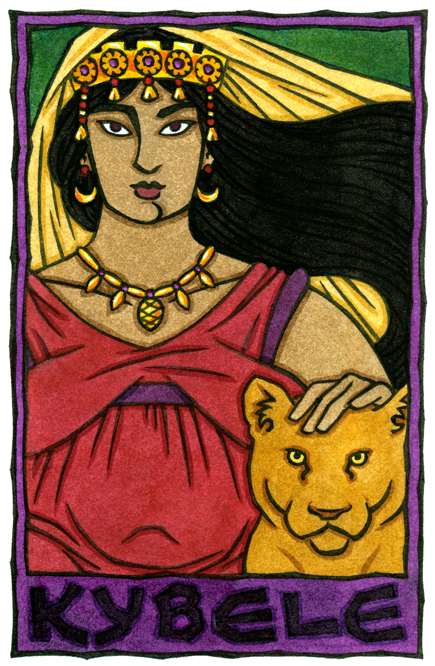 I have deep roots.
Kybele is an ancient Anatolian Goddess, Anatolia being the old name for (roughly) modern Turkey; Her worship was adopted in Greece, and later Rome. She was known for orgiastic worship, with wild dances and drumming and cymbal-playing; but Her worship was looked upon a little askance, at least by the Romans. Probably this was because, in addition to the raucous partying aspect, some of Her priests practiced self-castration, in imitation of the story of Attys, the beloved of the Goddess. Attys was a beautiful boy, the son of a river-nymph, conceived when She ate an almond (i.e. parthenogenetically, a virgin birth); Kybele fell in love with Him, and made Him promise to be faithful to Her. Her swore He would; but in time He fell in love with a hamadryad named Sagaritis. When Kybele found out She cut the nymph's tree down, thus killing Sagaritis; and Attys went mad on a mountaintop, castrating Himself. He died under a pine tree, and the blood from His wound sprang up as violets. A three-day festival was celebrated to Him in the spring, in which a pine tree was decorated with violets (echoes of the Maypole, though I don't know that they are necessarily connected); and for two days the participants mourned and searched for Attys with wild rites. On the third day, however, He was found; and the mourning and sadness turned to joy at His rebirth. That is the Classical version of Her story. But Kybele has deep roots; so what of Her Anatolian origins? The Attys story is something that was attached to Kybele at rather a late date and is not known before the 6th century BCE. Kybele Herself is a particularly complex Goddess, and would appear to have a variety of strands making Her up; one of them may trace back to the deified Sumerian Queen Kubaba, Who was eventually adopted into the Hittite pantheon through the Hurrians, where She was identified with Hannahhannah (She, Who, in the story of Telipinu sent the bee to wake Him); She may also be related to the Hurrian Mother-Goddess Hebat. She may even, though this is pretty speculative, be related to the Goddess depicted in the famous statue from Çatalhöyük, a neolithic city in southern Anatolia, dating from the eight to sixth millennia BCE. This small statue shows a large, nearly nude woman perhaps giving birth, seated on a throne flanked by lionesses; though there is quite a large gap in time, it does recall later depictions of Kybele, Who was shown in much the same way, enthroned with a lion to either side. I have shown Her here in that ancient pose. Kybele is wildness and civilization both; or, She is the wildness within us that does not ever die despite being civilized. Also spelled Cybele in the Roman style. This design is available on prints at ArtPal. |